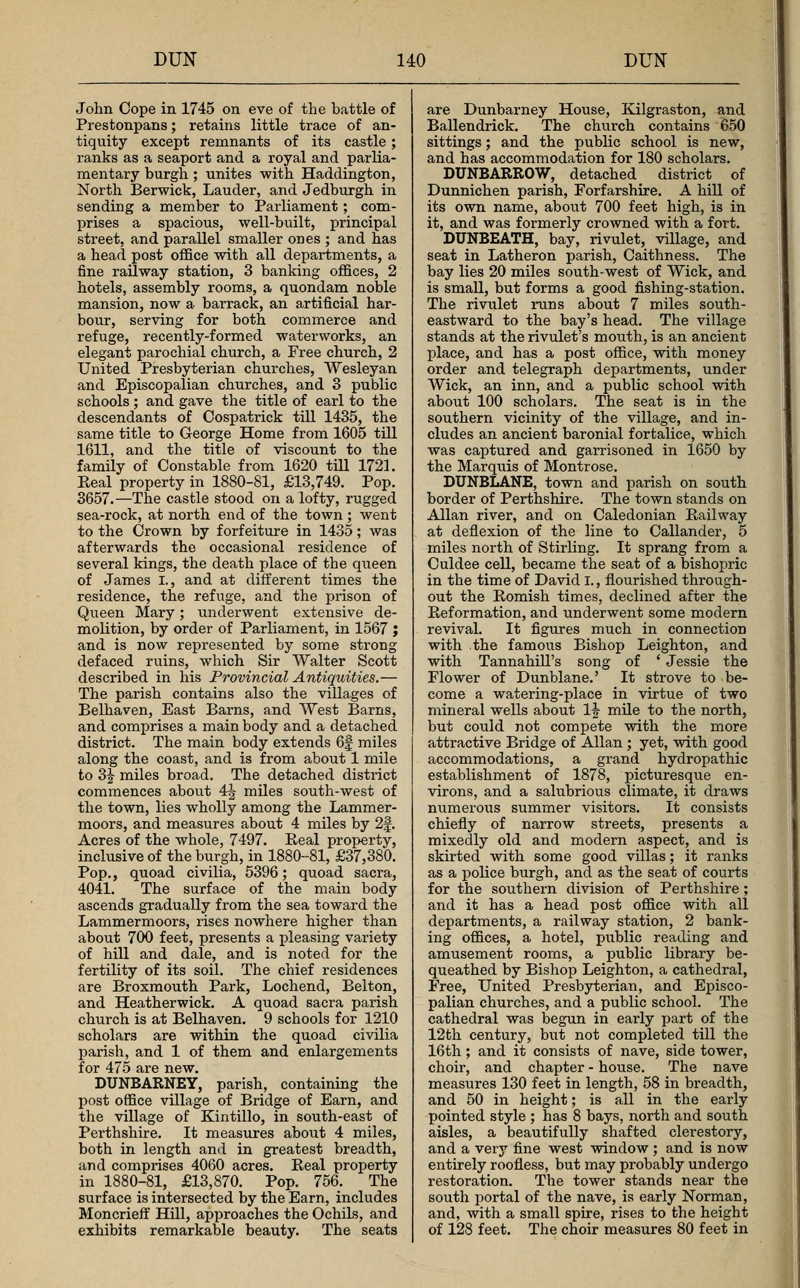DUNBARNEY, parish, containing the post office village of Bridge of Earn, and the village of Kintillo, in south-east of Perthshire. It measures about 4 miles, both in length and in greatest breadth, and comprises 4060 acres. Real property in 1880-81, 13,870. Pop. 756. The surface is intersected by the Earn, includes Moncrieff Hill, approaches the Ochils, and exhibits remarkable beauty. The seats are Dunbarney House, Kilgraston, and Ballendrick. The church contains 650 sittings ; and the public school is new, and has accommodation for 180 scholars.
DUNBARROW, detached district of Dunnichen parish, Forfarshire. A hill of its own name, about 700 feet high, is in it, and was formerly crowned with a fort.
DUNBEATH, bay, rivulet, village, and seat in Latheron parish, Caithness. The bay lies 20 miles south-west of Wick, and is small, but forms a good fishing-station. The rivulet runs about 7 miles south-eastward to the bay's head. The village stands at the rivulet's mouth, is an ancient place, and has a post office, with money order and telegraph departments, under Wick, an inn, and a public school with about 100 scholars. The seat is in the southern vicinity of the village, and includes an ancient baronial fortalice, which was captured and garrisoned in 1650 by the Marquis of Montrose.
DUNBLANE, town and parish on south border of Perthshire. The town stands on Allan river, and on Caledonian Railway at deflexion of the line to Callander, 5 miles north of Stirling. It sprang from a Culdee cell, became the seat of a bishopric in the time of David I., flourished through-out the Romish times, declined after the Reformation, and underwent some modern revival. It figures much in connection with the famous Bishop Leighton, and with Tannahill's song of ' Jessie the Flower of Dunblane.' It strove to be-come a watering-place in virtue of two mineral wells about 1 mile to the north, but could not compete with the more attractive Bridge of Allan ; yet, with good accommodations, a grand hydropathic establishment of 1878, picturesque environs, and a salubrious climate, it draws numerous summer visitors. It consists chiefly of narrow streets, presents a mixedly old and modern aspect, and is skirted with some good villas ; it ranks as a police burgh, and as the seat of courts for the southern division of Perthshire ; and it has a head post office with all departments, a railway station, 2 banking offices, a hotel, public reading and amusement rooms, a public library bequeathed by Bishop Leighton, a cathedral, Free, United Presbyterian, and Episcopalian churches, and a public school. The cathedral was begun in early part of the 12th century, but not completed till the 16th ; and it consists of nave, side tower, choir, and chapter-house. The nave measures 130 feet in length, 58 in breadth, and 50 in height ; is all in the early pointed style ; has 8 bays, north and south aisles, a beautifully shafted clerestory, and a very fine west window ; and is now entirely roofless, but may probably undergo restoration. The tower stands near the south portal of the nave, is early Norman, and, with a small spire, rises to the height of 128 feet. The choir measures 80 feet in length, 30 in breadth, and 48 in height ; is all likewise in the early pointed style ; includes, on its north side, what is called the chapter-house ; has been used since the Reformation as the parish church ; and was renovated in 1873. Pop. of the town, 2186. The parish contains also the villages of Kinbuck, Balhaddie, Buttergask, Greenloaning, and Rottearn. Its length is about 9 miles ; its breadth about 6 miles; its area 18,543 acres. Eeal property in 1880-81, 27,727. Pop. 3123. The surface includes a skirt of the Ochil Hills in the east, the middle or main part of Strathallan in the centre, and a skirt of the Braes of Doune in the west. The hill tracts are mostly bleak and moorish ; and those in the east comprise Sheriffmuir, the scene of the famous battle in 1715. The strath tracts are much diversified, but present many amenities and much beauty ; and one near the town, but partly beyond the parish, exhibits a gorge somewhat similar to the Trossachs. The chief seats are Keir and Kippendavie. 3 schools for 519 scholars are in the parish, and enlargements of them for 259 are new.

